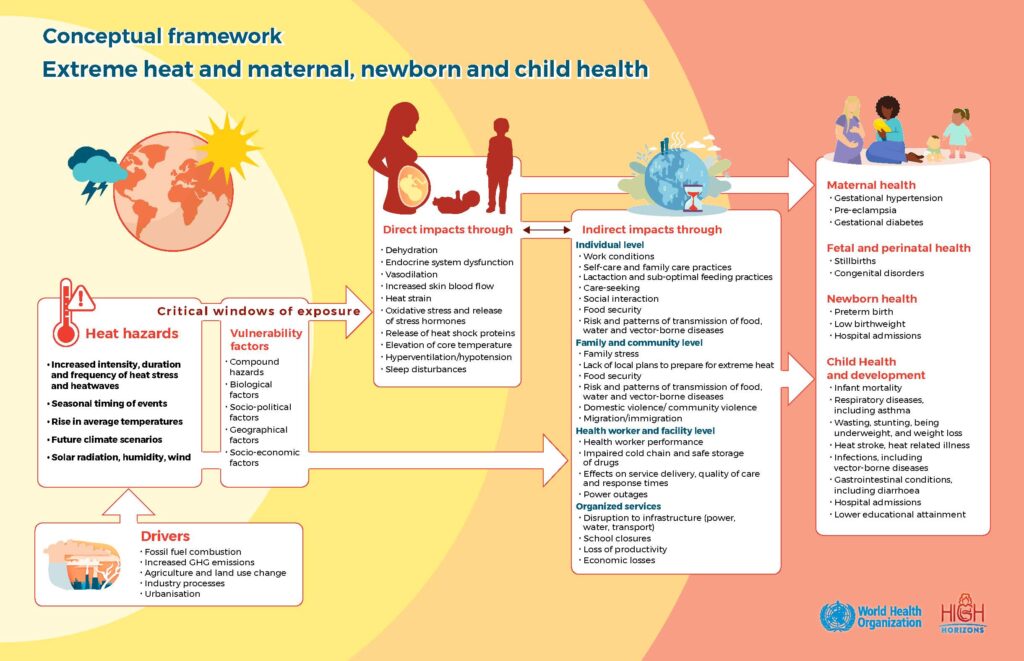HIGH Horizons, alongside the World Health Organization (WHO), has developed a conceptual framework for extreme heat and maternal, newborn and child health.
We spoke with Annie Portela, Department of Maternal, Newborn, Child and Adolescent Health and Ageing at the WHO, about developing the framework, what WHO and HIGH Horizons aim to achieve with it and who it is intended for.
Why is this conceptual framework important?
what does the conceptual framework do?
The conceptual framework aims to depict the direct (pathophysiological mechanisms) and indirect (individual, community and health services) pathways through which heat exposure can lead to adverse maternal, newborn and child health (MNCH) outcomes. Underlying health conditions, geographical location, socioeconomic and socio-political factors can all additionally multiply the effect of extreme heat on MNCH.
The framework is really meant to provide a broad understanding of extreme heat and MNCH at a more precise level, including different types of impacts and some of the factors that contribute to heat impacting on maternal and child health.
Who is it for? Why is it important they have it?
The impacts of heat on health is an area that’s of growing interest, and more studies are coming out and having this framework really helps everybody that’s sitting down at the table to talk about it, to do something about it and have some common understanding of how heat impacts MNCH.
I think there’s two main stakeholders we intend the resource to be used by. Firstly, when we talk to maternal, newborn and child health programme managers, they understand that heat is important and has its effect on health, but they themselves aren’t always sure about the particularities, and this gives an easy way to summarise all the different pathways and factors that heat can have impact. This graphic and this understanding will help them to talk to their stakeholders, talk to women, talk to health workers, and to come to some decisions about what they can do in their programmes to help reduce these impacts and safeguard MNCH.
The second is for researchers and others working in this area. It helps us to better establish the evidence base. It gives us a broad understanding and overview of the different ways or mechanisms of action and how it impacts health. We can map to this what are areas that are already studied and what areas where we lack knowledge. So, I think it’s a really good tool to help those of us working in maternal and child health to speak to each other, share knowledge and decide on the way forward to strengthen our work both in research and programmes.
How do social, political and economical factors intersect with the framework?
It is important to study these different issues in different contexts. Factors such as socioeconomic factors really matter, different conditions just multiply the effect of heat and make those living in certain conditions experience the impacts of heat even more.
For example, it’s very different if I live in a house with air conditioning versus if I live in a house with little ventilation, a tin roof and have no way to escape the heat.
It’s very different if I have a clean water supply and can just go to my refrigerators to drink all the water I want versus if I have to walk 10 kilometers to get water, and I have to use it very sparsely. Under that scenario am I going to drink a lot of water to hydrate? Probably not.
All these different conditions just multiply the effects of heat, living in certain conditions means that the impact of heat is going to be much stronger for specific groups.
How does this framework communicate key messaging to policymakers, stakeholders, and the general public?
I think it’s important to have an enhanced understanding of both the direct and indirect impacts of heat. I know sometimes we like to write and talk to policy makers with the big impacts such as mortality, but that’s not what we’re seeing, and that’s not what the studies are looking at.
I think the conceptual framework again helps in a discussion to policymaker to understand what are the hazards or the risks? What are we talking about in our research? What are some of the things that multiply that effect?
And then the different pathways, the direct and indirect, if I want to stop these impacts or reduce the risk I need to understand the direct and indirect. It really helps to have a more granular understanding of the pathways, and that will help policymakers to think better about what they need to put in place, and for which populations in particular to reduce the impact of heat.

